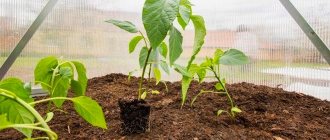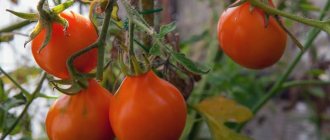Greetings. You know, the answer to the question: “How to grow tomatoes in a greenhouse?” , I have known since childhood. Grandfather and grandmother grew tomatoes both for themselves and for sale. We always had early tomatoes on the table, and this is all because they planted tomatoes in the greenhouse using seedlings.
And I would like to share with you the secrets of an early and rich harvest. Tell you how to properly grow seedlings and their subsequent planting in a greenhouse. I will share family secrets on caring for tomatoes and combating possible difficulties: pests and diseases. And following my recommendations you will grow an early harvest of tomatoes. I suggest studying and implementing.
Why do I grow tomatoes with seedlings in a greenhouse?
I turn to growing tomatoes in greenhouse conditions for a lot of reasons:
- Possibility of harvesting ultra-early and late harvests - from early spring to late autumn.
- Growing tall bushes that do not take root well in open ridges. It is these seedlings that produce large fruits up to 0.5 kg.
- The possibility of planting productive heat-loving varieties that do not do well in harsh Russian conditions.
Greenhouse plants do not require additional care - all activities are simple and familiar, even a beginner can do it.
tall tomatoes in a greenhouse
Preparation for transplantation - measures for good survival
To ensure that tomato seedlings in a greenhouse are not susceptible to diseases, return frosts and other troubles, it is necessary to properly prepare them for moving to greenhouse conditions. Despite all the conditions for survival that we create in greenhouses, planting seedlings is a serious stress for them. Even minor changes in lighting affect the well-being of the shoots. After all, glass or polycarbonate refract the light of the sun in completely different ways. To prevent the seedlings from being damaged, we recommend taking measures such as hardening, fertilizing and spraying.
We begin hardening 14–21 days before the intended planting. We implement the procedure by reducing the frequency and intensity of watering. At the same time, we accustom the seedlings to lower temperatures. Initially, we cool the air in the room by only 4–5 degrees. To do this, you need to open the window for several hours during the day. On warm days, you can take the tomatoes to the balcony or outdoors. If possible, we accustom young plants to the greenhouse by moving the boxes to this place.
We feed tomatoes 7 days before planting. Let's prepare the solution ourselves: stir one glass of wood ash in a bucket of water, then water the plants with the resulting substance. If for some reason the transplantation of tomatoes has to be postponed to a later date, and the seedlings suffer from a lack of moisture, there is no need to neglect watering. We irrigate the seedlings moderately and only in the morning. Seedlings with formed flower clusters require additional preparations. To prevent the flowers from falling off in the greenhouse, we spray them with a solution of boric acid 3-4 days in advance. The tincture should be warm; to prepare it, dilute 1 teaspoon of the drug in 1 liter of water.
Limiting the intensity of irrigation will help maintain the growth of tomatoes, hardening will get used to possible temperature changes and weather changes, and fertilizing will give vitality. All of these measures increase the percentage of seedlings’ survival in new conditions. We have already sorted out the planting dates and preparatory work. It's time to move on to the actual planting of plants. First, let's prepare the holes in the greenhouse. We dig them 15–20 cm deep in one or two rows in the garden bed.
Advice! Before planting, the soil must be disinfected. For this purpose, pour a hot (60 degrees) potassium permanganate solution into the soil. We prepare it from 1 gram of the substance, diluted in a bucket of heated water.
For weak seedlings, we add additional amounts of potassium, nitrogen and phosphorus fertilizers. If the seedlings are healthy and strong, the fertilizers that were applied when preparing the soil are sufficient.
It is strictly prohibited to add organic substances. They promote the active development of foliage, not the ovary. Before planting the plants, pour half a bucket of water into each hole, then place the bushes vertically in the resulting dirt. Sloping planting provokes the development of secondary roots, which strong seedlings do not need at all. In addition, this addition slows down the formation of ovaries and the period of fruiting.
We remove the lower leaves before transplanting. Over time, the soil around the planted bush will compact a little, so the distance between the soil and the first leaves on the stem should be approximately 2–3 cm. This ensures the necessary circulation of air masses. We immediately install pegs near the hole; this support will be useful in the future for tying up adult plants. This should not be done later, as there is a danger of harming the rhizome. When all the bushes are in their places, we begin mulching the beds. After 5–6 days, carefully loosen the soil. Over the next 2–3 weeks, the seedlings will grow quite slowly, but then their development will accelerate.
The distance between planting holes and ridges differs for different varieties. Traditionally, we plant tomatoes in wide beds in two rows. We plant tall-growing species, as well as tomato trees and tomato vines in one row. On average, the distance between the holes should be at least 50–60 cm, so the plants will not interfere with each other as they grow.
When to plant tomatoes in a greenhouse
I determine the readiness of tomatoes for moving by the following criteria:
- Height 20-25 cm.
- 8-12 developed true leaves.
- Formation of 1-2 inflorescences.
- Approximate age: 50-55 days.
I will also introduce you to the approximate dates.
Planting tomatoes by region
Planting seedlings in heated glass greenhouses:
- Northern regions: early May.
- Mid-latitudes: end of April.
- Southern regions: early to mid-April.
Moving to unheated greenhouses:
- Northern regions: second half of May.
- Middle latitudes: first ten days of May.
- Southern regions: end of April.
Planting in light film greenhouses:
- Northern regions: early June.
- Mid-latitudes: end of May.
- Southern regions: early to mid-May.
I advise you to focus on the characteristics of a particular year - cold summer, warm spring, sharp frosts, prolonged thaw, etc.
Planting tomatoes according to the lunar calendar
I will list the favorable dates according to the lunar cycles for 2021:
- in January 2021, you can plant tomatoes for seedlings on 2, 14, 17, 18, 20;
- in February 2021, 6th - 9th, 11th, 12th, 14th;
- in March it is best to plant tomatoes 7 - 10, 15, 16
- In April, the best planting days for tomatoes are 6, 7, 11 - 12, 17, 18.
- May when to plant tomatoes: 2, 3, 8,9, 15 - 18.
The seedlings planted these days develop strong, healthy, and disease-resistant.
tomato seedlings
Air temperature and humidity
At different growth stages, tomatoes need different air temperatures. So, to grow seedlings, it is necessary to maintain the temperature at about 25 ºС.
At the beginning of fruiting, it should be 20–22 ºС (in cloudy weather a couple of degrees lower) during the day and 16–17 ºС at night. To ripen fruits, it is necessary to maintain the temperature at 24–26 ºС during the day and 17–18 ºС at night.
Even a slight increase in night temperature leads to a deterioration in the quality of fruits. If the morning is hot and sunny, it is necessary to ventilate to avoid burns on the plants due to condensation that forms due to temperature changes.
In general, tomato is a crop that loves drafts, so it is more convenient to grow them in polycarbonate greenhouses. In such greenhouses, unlike film ones, it is easy to install windows that can be opened if necessary.
Important! To monitor such important indicators as temperature and humidity, we recommend installing a thermometer and hygrometer in the greenhouse.
Humidity in the greenhouse is ensured quite simply, because evaporation occurs much more slowly. The optimal humidity for this crop is 60–70%. During the flowering period, humidity must be slightly reduced, since its increased value prevents the spread of pollen. Excessive humidity can also cause putrefactive lesions of bushes and the development of late blight.
Timing of sowing seeds
Vegetable growers live in different regions; the climate in Russia is not the same. Naturally, the timing of planting seedlings in a polycarbonate greenhouse will be different.
How to determine the timing of sowing seeds for a heated greenhouse in any region:
- Tall tomatoes are sown for seedlings from the end of February to March 10.
- Seeds of early and medium-ripening varieties should be sown between February 20 and March 10.
- Ultra-early tomatoes, including Cherry, in early April.
- Sowing of late tomatoes for seedlings is carried out after February 20.
Attention! If the greenhouse is unheated, then, naturally, all deadlines are postponed by two or three weeks.
In the Urals and Siberia, when growing tomato seedlings that ripen late, the timing will be different. Seeds are sown in heated polycarbonate greenhouses at the end of March, beginning of April. For other tomatoes from the 20th of April. You can use the gardener’s calendar, but compiled for a specific region. By the way, some vegetable growers sow seeds when the Moon is in:
- Scorpio;
- Corpuscle;
- Cancer;
- Libra.
They believe that in these cases the seedlings grow strong and when the time comes to plant them in a polycarbonate greenhouse, they meet all technical parameters.
Favorable days according to the lunar calendar for sowing seeds for seedlings (general data):
- in February – 5-9, 18-23;
- in March – 8-11, 13-15, 17-23, 26-29;
- in April – 5-7, 9-11, 19-20, 23-25;
- in May - all days except 15 and 29.
Review of favorite tomato varieties for planting in a greenhouse
Let me introduce the reliably proven varieties of greenhouse tomatoes:
- Major. Indeterminate high-yielding tomato. Fruits with dense pink pulp and a pleasant smell. The variety is resistant to both unfavorable conditions and diseases.
- Miracle of the earth. A high-yielding and early-ripening variety that is very popular among gardeners. The seedlings are tall, the fruits are heart-shaped, very sweet. Some tomatoes can reach a weight of up to 900 g. Plants are resistant to sudden temperature changes and drought.
- Gondola. Mid-season, indeterminate hybrid variety. The fruits weigh 150-500 g. The pulp is red and dense. Tomatoes have excellent keeping quality. They can be eaten fresh, salted, pickled, as part of side dishes and sauces.
- Kohawa. Ultra-early ripening and high-yielding variety. The tomatoes are flat round, weighing up to 150-180 g. The first fruits appear on the 90th day of the plant’s life. The seedlings are resistant to fungal diseases.
- Silhouette. High-yielding mid-early hybrid tomato. The fruits have an unusual rounded-flattened shape with excellent taste. The variety is resistant to unfavorable conditions.
- Dina. Mid-season productive variety. The seedlings are medium-sized, the fruits are round, large (150-200 g), very sweet, interesting bright orange color, rich in keratin. The variety is resistant to diseases and drought.
- Lelya. A recent discovery by breeders is an early ripening and high-yielding tomato. The fruits are small (up to 100 g) with bright red tasty pulp.
- Hurricane. An early-ripening, productive variety. The average weight of tomatoes is 80-90 g. Suitable for consumption fresh, pickled, or processed. The first harvest is harvested 85-90 days after planting.
- Long Keeper. Late high-yielding variety. The plant is of medium height, the fruits are large (up to 300 g), round. Tomatoes ripen well when stored.
- Bull's heart. A variety that has long won recognition among gardeners. Depending on the variety, it produces black, red and yellow fruits weighing up to 300 g, with juicy and fleshy pulp. The plant has record yields.
I never stop at one variety. I prefer to grow ultra-early, mid-ripening and late-ripening ones so that I have delicious tomatoes on my table all summer. When choosing a tomato variety, I focus on the following characteristics: yield, shelf life, ripening time, taste, bush size, approximate weight, fruit size.
tomato varieties
Which varieties to choose?
When choosing a tomato variety for a carbonate greenhouse, you need to pay attention to the following qualities:
- Self-pollinating.
- Ability to grow into one stem.
- Disease resistance.
- The ability to easily tolerate excess humidity.
You can choose both low-growing and tall-growing tomatoes, early and medium ripening, for growing. The most popular varieties are:
Mikado pink
Large pink fruit (up to 600 g) for universal use, the plant reaches 2 meters, has excellent immunity. More than 5 kg of fruit can be collected from one bush.
Pink raisins
The fruits are of excellent taste, medium-sized. Fruiting is long and abundant.
King of Kings
A real giant, the fruits reach 1 kg, tasty and juicy. Resistant to rot and late blight, reaches a height of 1.8 m.
Junior F1
An ultra-early hybrid variety, the fruits are bright red, oval in shape, weighing about 100 g. The bush grows up to 50 - 60 cm in height.
You can learn more about tomato varieties for greenhouses from the video:
How to grow tomato seedlings correctly
A rich harvest begins with proper seedling preparation. I take care of future plantings by purchasing seeds and breeding seedlings.
Preparing seeds for sowing tomatoes
I approximately sow seeds for seedlings from the beginning of February to the last days of March. The timing varies depending on the type of culture:
- Early. End of March.
- Mid-season. Continuing March.
- Late. End of February.
If you do not want to spend time preparing seed, I recommend purchasing coated seeds that have already been processed by the manufacturer. They are planted in the ground immediately, dry. The rest of the seeds require simple preparation:
- Disinfection in Fitosporin solution for 15 minutes.
- Soak for 15 minutes in a growth stimulator solution. I use sodium humate: ¼ teaspoon per 1 liter of water.
After such simple preparation, the seeds are ready for sowing.
treatment of tomato seeds with Fitosporin-M
Preparing the soil for seedlings
Tomato seedlings do not require special soil - any fertile and loose soil will do. I buy humus and turf soil treated from viruses, fungi and pests at the garden center. You can pay attention to special soil mixtures for nightshades and tomatoes. “Living Earth” and “Tomato and Pepper” soil are popular.
Planting seeds for seedlings is simple:
- Make holes in the bottom of each container to drain excess water and allow air to reach the roots.
- Pour the soil mixture into the prepared cups.
- Make shallow (1-1.5 cm) grooves. If you have prepared the boxes, maintain a distance of 5-7 cm between them with the indentations.
- Spill the soil with heated water.
- Place the seeds in the depressions, cover with soil, and compact the substrate a little with your hands.
- Cover with glass or wrap with cling film.
- Place containers on pallets.
Now you need to move the boxes and glasses to a well-lit, warm place and wait for the first shoots.
Caring for tomato seedlings
The first seedlings appear after 7 days. By the 5th week of development, the gardener makes sure that the plants do not stretch out - this is the time of their increased growth. The seedlings are kept in a well-lit place, the pots are turned 180 degrees every day so that the seedlings do not reach for the light.
The temperature regime is maintained as follows:
- First week. During the day – 16-18 C, at night – 13-15 C.
- Before the dive. During the day – 18-20 C, at night – 15-16 C.
- After the pick. During the day – 20-22 C, at night – 16-18 C.
- Before moving to the greenhouses. During the day – 18-20 C, at night – 15-16 C.
With watering, things are as follows:
- The first watering is when sprouts appear.
- The second – after 7-14 days.
- The third is before the pick.
- After picking - weekly watering.
Use water heated to room temperature, and water the plants at the roots.
After picking, additional feeding is needed:
- A week later. 1 tbsp. spoon of nitrophoska per 10 liters of water. Consumption: 1/2 cup of suspension per 1 bush.
- In 14 days. For 10 liters of water – 1 tbsp. spoon of the drug “Signor Tomato”, 1 tbsp. spoon of superphosphate. Consumption: 1 glass of solution per 1 plant.
- In 2 weeks. For a bucket of water - 1 tbsp. spoon of nitrophoska. For 1 bush – 1 glass of solution.
Fertilizing is carried out after watering. If the soil settles, add more substrate.
Picking tomatoes
If you are propagating seedlings in common boxes, when 2-3 leaves appear, the seedlings are given a pick:
- Take pots with a height and diameter of 8 cm, fill them with the same seedling soil mixture.
- Spill the soil with manganese solution (0.5 g per 1 liter of water).
- Transplant only the strongest and most robust seedlings.
When picking, you can bury seedlings that are too elongated up to the cotyledon leaves.
picking tomatoes
How to pick tomato seedlings: video
How to prepare tomato seedlings for planting in the ground
Already in April - May it is worth starting hardening:
- Open windows in rooms where plants are located. Start with several hours, gradually increasing the ventilation time. At the same time, avoid drafts.
- As soon as the weather gets warm outside, move the plants to the balcony. Start with a 2-hour “walk” and gradually increase the time.
Hardened seedlings acquire a characteristic greenish-purple hue. It should be sent for “walks” pre-watered.
The last preparatory step is pinching 2-3 lower leaf plates. In their place, short “stumps” (2-3 cm) are left. This promotes improved air circulation and good lighting of the plantings.
Soil preparation
Regardless of which greenhouse you plan to plant tomatoes in, one of the most important indicators of a good harvest is well-prepared soil. This is one of the significant advantages of the greenhouse method of growing tomatoes compared to planting them in open ground - because here you have the opportunity to independently prepare the most suitable soil composition for the growth of vegetables.
As a rule, a greenhouse is installed on a site and the soil that is located on it is used for it. But if you want to achieve high yields of tomatoes, you will have to carry out work to improve the soil.
The soil for planting tomatoes should be loose, light and have good breathability.
In the process of preparing the soil, you should be guided by the following recommendations:
- In the case of clay or loamy soil, in order to improve its structure in the greenhouse, it is necessary to fertilize it with a bucket of humus, peat and sawdust (a bucket per 1 square meter).
- When the site mainly consists of peaty soils, you should add a bucket of small shavings, humus and turf soil, as well as half a bucket of coarse sand per square meter.
- If chernozem predominates in the greenhouse, a bucket of humus and half a bucket of coarse sand are added per square meter.
In addition to organic fertilizers, it is also necessary to use mineral fertilizers - if you adhere to the specified dosage, they will be very beneficial for the plants and will help you get a good harvest of tomatoes. It will be enough to add 1 teaspoon of ammonium nitrate and 3 teaspoons of superphosphate per square meter of soil.
If possible, you can additionally add 1-2 tablespoons of wood ash (it contains many useful microelements that are easily absorbed). After all these manipulations, the beds should be dug well and the soil in them should be loosened.
Agronomist experts do not recommend planting tomatoes in the same soil for several years in a row. This is explained by the fact that pests and diseases can survive in the soil for a long period of time, and they will nullify all your efforts to get a good harvest of tomatoes in a polycarbonate greenhouse.
If possible, the best solution would be to build two greenhouses at once and plant tomatoes and cucumbers in them alternately: one year you plant tomatoes, and the next year you plant cucumbers. If there is only one greenhouse, the tomatoes should be planted in the place where cucumbers grew last season; it is first necessary to remove 10-12 centimeters of the top layer of soil from the bed, this way the seedlings are protected from damage to the rhizomes by rot.
When replacing the top layer of soil, it should be disinfected; for this purpose, a hot solution of copper sulfate is used at the rate of 2 tablets of oxychome per ten liters of water.
Preparing a greenhouse for planting tomatoes
Before moving tomatoes, you need to properly prepare the greenhouse. I will introduce you to the techniques that I use personally.
How to prepare the soil for planting tomatoes
Traditionally, I replace greenhouse soil once every five years. During this time, it manages to be completely depleted, even if you regularly applied fertilizers.
First thing in the fall, I disinfect the greenhouse substrate using improvised means:
- A solution (1%) of Bordeaux mixture.
- Suspension (1%) of copper sulfate.
- Dolomite flour (50 g per 1 m2).
Then I proceed to the actual preparation of the land:
- I arrange the lower insulating layer - first a 10-centimeter layer of sawdust, dry pine needles or straw. On top is another 10-centimeter layer of rotted compost.
- I fill the insulating bedding with garden soil - it turns out to be a raised ridge 30-40 cm high.
- If the ground is turf, fertilizers are applied during digging (per 1 m2): 3 tbsp. spoons of superphosphate in granules, 1 tbsp. spoon of potassium magnesia, 1 tbsp. spoon of potassium sulfate, 2 tbsp. spoons of ash, 1 teaspoon of urea (replacement - sodium nitrate).
- If the soil is clayey or loamy, an additional bucket (per 1 m2) of peat, humus and crushed sawdust is required.
- If the substrate is peat, additionally add (per 1 m2) 1 bucket of turf, humus, wood shavings or sawdust, and ½ bucket of coarse sand.
After such preparation, the greenhouse is completely ready for the spring transfer of seedlings.
Temperature
Tomatoes can be transplanted into a greenhouse when the temperature is set:
- Priming. Not lower than 13 C at a 10-centimeter depth.
- Air. 20-25 C.
If your greenhouse is heated, these conditions can be created artificially at any time - plant seedlings in early spring and eat fresh tomatoes until late autumn.
Preparing the greenhouse for planting tomatoes
Preparation of the greenhouse for planting tomatoes next year begins in the fall. A mandatory step is disinfection. All plant debris is removed, the surfaces are wiped with a solution of slaked lime or a small piece of sulfur is burned inside.
When working with a sulfur bomb, carefully study and follow the instructions verbatim
The soil needs to be completely changed every 5–6 years. Before the time has come, remove the top 10–12 cm of soil, dig up what remains, and cover the surface with humus or rotted compost. If the main substrate is heavy, sand or sawdust from deciduous trees is added to it in a ratio of 2:1, otherwise powdered clay is added in the same proportion. Then add the necessary fertilizers - 60–70 g of simple superphosphate, 40–50 g of potassium nitrate, 15–20 g of urea per 1 m². With high acidity, dolomite flour (150–200 g/m²) is also needed.
Humus is a natural remedy for increasing soil fertility
Adherents of natural agriculture can plant future beds with green manure (mustard greens, phacelia, clover, rye) at the beginning of September. After about a month and a half, the greens are mowed and embedded in the soil. Wood ash will be a source of potassium and phosphorus (1.5–2 cups per 1 m²).
Leaf mustard, like other green manures, saturates the soil with nitrogen and loosens it
After 2-3 days, water the substrate with 5% copper sulfate, Bordeaux mixture, or a solution of any fungicide prepared according to the instructions. Regular boiling water is also suitable for disinfection. The finished bed is covered with polyethylene until spring. 1.5–2 weeks before planting tomato seedlings, they are thoroughly loosened and the soil is once again disinfected by watering with a hot (55–60ºС) solution of potassium permanganate of a rich crimson color.
Bordeaux mixture is a means for disinfecting beds and combating pathogenic fungi, the effectiveness of which has been proven by many generations of gardeners
Video: how to prepare a greenhouse for planting tomatoes
How to plant tomato seedlings in a greenhouse step by step
I will present popular schemes for planting tomato seedlings:
- Low-growing and early-ripening, developing into 2-3 stems. Checkerboard arrangement: between rows - 50-55 cm, between plants in one line - 35-40 cm.
- Determinate, standard. Between rows - 40-45 cm, between bushes of the same row - 20 cm.
- Gigantic. They are planted staggered according to the following pattern: between rows - 75-80 cm, between tomatoes of the same row - 55-60 cm.
I plan the transplant itself on a cool, cloudy day. I will present simple step-by-step instructions:
- I make holes 40 cm deep.
- I pour a warm (50-60 C) suspension of potassium permanganate. For 10 liters of water - 1 g of potassium permanganate. One well requires 1-1.5 liters of solution. An alternative is disinfection with Zaslon. You need 250 g of product per 10 liters of water. Consumption per well is 0.5 liters of solution.
- I plant the seedlings with a ball of earth directly into the soil, liquefied by irrigation. If tomatoes were grown in peat cups, I do not remove them.
- I plant low-growing plants straight, overgrown plants at a slight angle.
- I place the tomatoes with already formed inflorescences towards the greenhouse aisle so that they are not shaded by their neighbors.
- I cover each seedling with loose soil and compact it with my palms.
- Finally, you need to add mulch - last year's compost, straw, sawdust, mowed and dried grass.
Some gardeners leave a small hole near each tomato - this is convenient for economical root feeding.
Planting in a greenhouse
Tomato seedlings at the time of transplantation into closed ground should have about 8-10 leaves on the stem. In this case, the stem part should be well built and quite dense, and the root should be strong and massive. When planting, the cotyledon leaves must be removed. Tomatoes are planted in the evening or on a cloudy day.
The beds in the greenhouse should be 25-30 cm high and 60-90 cm wide. A distance of approximately 60-70 cm should be maintained between the rows. Low-growing tomato varieties, as a rule, are early ripening and are planted in a checkerboard pattern in 2 rows . The bushes are placed at a distance of 45 cm between each other. Row spacing should be from 45 to 50 cm. Standard varieties develop only one shoot, so they can be planted more densely. The distance between the stems can be left 25-30 cm. Tall varieties require wide spaces for their growth, so they are planted in 70 cm increments.
It is enough to dig holes in the greenhouse to a depth of 15 cm. They are first disinfected with a strong solution of manganese. 20-30 minutes before planting, water with warm water. Plants are removed from jars or placed in the ground along with peat pots. Ideally, it would be good to lightly trim the roots of the tomatoes, then they will grow wider and be much stronger.
If the tomato seedlings are overgrown, then you can use the following planting method:
- form and water long, narrow holes;
- trim the lower leaves of the seedlings and plant them in a semi-horizontal position;
- the root should be laid out in the furrow, and the top should remain on the surface in a horizontal position;
- the holes are sprinkled with loose soil and watered with 2 liters of water for each plant;
- the upper part of the tomato stem is tied to a peg;
- shade is created for seedlings for 2-3 days.
Greenhouses made of polycarbonate are the most reliable and convenient. Tomatoes in such shelters feel most protected, develop fully and produce a good harvest. Maintaining polycarbonate greenhouses is not particularly difficult; you just need to take into account a few rules for maintaining such shelters.
Caring for tomatoes after planting
After transplanting, I don’t touch the tomatoes for 5-6 days - I give them time to adapt to unusual conditions. After a week, I carefully loosen the soil around each bush to improve air access to the roots. Then you can begin periodic care.
How to properly water tomatoes in a greenhouse
I want to talk in detail about the features of watering tomatoes:
- This crop requires relatively moderate but frequent watering.
- After each watering, loosening and ventilation are required.
- For water procedures, use water heated under the sun. Pour it into buckets, barrels in the morning, and use it already warm for evening watering.
- It is best to water the plants manually using a hose (at low pressure) or a watering can.
- Tomatoes are watered only at the root. Even the smallest drops of water falling on the leaves can cause sunburn.
Let me present a schedule of water treatments:
- After transplantation, do not water the seedlings for 7-10 days. Otherwise, the development of the root system will be inhibited, and the green part will stretch out.
- Before the fruit starts to set, plants need frequent and abundant watering - once every 5-6 days. One bush needs at least 4-5 liters of water in one sitting. The soil should be well moistened to a depth of 15-20 cm.
- When the first tomatoes appear, watering is increased to once every 3-4 days. However, water consumption is reduced - 3-4 liters per bush is enough.
The fact that the plant is suffering from thirst can be easily understood by the curled upper leaves. And if there is an excess of moisture, even young tomatoes begin to burst.
How to fertilize tomatoes in a greenhouse
Greenhouse tomatoes need 3-4 feedings during the summer season. I traditionally follow this schedule:
- 3 weeks after transplant. For 10 liters of water – 1 tbsp. a spoonful of nitrophoska, 0.5 liters of liquid cow manure. For each bush - 1 liter of solution.
- After 10 days. For 10 liters of water – 1 tbsp. spoon of superphosphate, 1 teaspoon of potassium sulfate. Approximate consumption: ½ bucket of suspension – per 1 m2.
- In 2 weeks. For 10 liters of water - 2 tbsp. spoons of ash, 1 tbsp. spoon of superphosphate. Consumption – 6-8 liters of fertilizer per 1 m2.
- When tomatoes begin to ripen. For 10 liters of water - 2 tbsp. spoons of superphosphate, 1 tbsp. spoon of potassium humate. Approximate consumption is ½ bucket of mixture per 1 m2.
Such complex fertilizing is sufficient for the harmonious development of the plant.
fertilizer for feeding tomatoes
How to grow tomatoes in a greenhouse
As a rule, I carry out the first stepsoning before the seedlings are moved or in the first days after transplantation. I always leave a 2-3 cm “stump” in place of each stepson. This is necessary so that a new process does not begin to develop in its place.
I will present to you the most important rules for growing greenhouse tomatoes:
- Pinch the shoots with your nails and disinfect your hands after each contact with plants to avoid becoming a carrier of infections.
- Plan the procedure in the morning - at this time the stems break off more easily.
- The frequency of stepsoning is 1 time per week.
- After the tomatoes are filled, do not forget to pluck all the lower branches. This is necessary to improve air circulation and prevent fruit rotting.
If you have few seedlings, do not throw away the shoots. Dip their torn ends into water - after a few days the strongest specimens will take root. They can also be planted in a greenhouse and wait for a small harvest.
Ventilation of tomatoes
Gardeners who plant tomatoes in a greenhouse sometimes forget about an important matter - ventilation. The procedure is needed after each watering of the plant. Tomatoes do not tolerate high air humidity. In such unfavorable conditions, the risk of late blight and other fungal infections increases.
I stick to the following temperature regime:
- Initial period of development: day – 20-25 C, night – 16-18 C.
- Formation, ripening of fruits: day – 24-25 C, night – 17-18 C.
The air humidity level should remain stably within 60-65%. Ventilation is especially important when tomatoes are flowering. If condensation forms, the tomatoes will grow tasteless, sour and watery.
How to tie up tomatoes in a greenhouse
When planting seedlings, do not forget to install supports - trellises or pegs - next to each bush. If there are few plants, the latter will be more convenient - use wooden slats, iron rods, and scraps of thin plastic pipes. The peg should be 20-25 cm higher than the plant. For stability, it is driven into the ground at approximately the same distance. The support is installed near the stem, gartering is carried out as necessary.
If you grow tall tomatoes, it is best to install permanent trellises. This will also save space in the greenhouse: it will be possible to plant 3-4 plants per 1 m2. Strong stakes up to 2 m high are driven in between rows. Wire or strong rope is pulled between them every 35-40 cm. Growing tomatoes are passed between the supports, forming a kind of “braid”.
garter pins
Some tips for proper care of tomatoes
The success of growing tomatoes in a polycarbonate greenhouse depends on many factors:
- varieties;
- seed health;
- temperature regime (25-28°C during the day, and not lower than 15°C at night);
- soil temperature (not lower than 17-18°C);
- air and soil humidity in the greenhouse (not higher than 65%);
- correctness of stepsoning;
When growing tomatoes, you need to remember some “don’ts”:
- Plants should not be grown in oily soil that is overly fertilized with organic matter;
- Bird droppings and manure should not be placed in holes for tomatoes, as they will cause the plants to turn into greens and not into fruits;
- You cannot fertilize tomatoes with mullein more than three times a season;
- You can’t put urea under the plants, you can only spray it once at the beginning of the growing season;
- Plants should not be planted in the shade or too densely;
- Do not overfill tomatoes with water.
After the second half of July, feeding tomatoes should be stopped.
What difficulties may arise when growing tomatoes in a greenhouse?
Greenhouse tomatoes are sometimes overcome by illnesses and enemies. But both pests and diseases can be successfully resisted using preventive, “therapeutic” methods.
Pest control on tomatoes
Let me introduce you to the most harmful enemies of greenhouse tomatoes:
- Wireworms. To prevent the spread of pests, about a week before moving the tomatoes, build simple traps: make holes around the perimeter, into which you place and bury a “kebab” on a stick - pieces of raw vegetables. After a few days, check the bait and destroy the pests. Wireworms can be found and collected manually by deep digging of the soil. Prevention of pest occurrence - liming, application of mineral fertilizers. When the disease is prevalent, use the insecticide “Bazudin” - according to the instructions, mix the powder with the soil.
- Medvedka. Pest eggs can enter the greenhouse when the soil is replaced. At the initial stages, it can be effectively resisted with folk remedies: infusion of red pepper (150 g per 10 liters of water), vinegar water (2-3 tablespoons per 10 liters) - approximately 0.5 liters of liquid are poured into the pest's burrows. If the problem is serious, turn to insecticides - “Thunder”, “Medvetox”, “Grizzly”.
- Whitefly. Before the tomatoes begin to bloom, the butterfly is effectively combated with Sochva liquid smoke. If the whitefly has completely flooded the greenhouse, spray with a “Phosbecid” suspension - 10 ml per 10 liters of water. Treatment is done before or after sunset. To consolidate the result, spraying is repeated twice more with a break of 15-20 days.
- Caterpillars and cutworm butterflies. Traps - jars of fermenting kvass - are effective against flying specimens. The drink is diluted with water (1:3), a little yeast is added. The caterpillars are collected by hand, and the tomatoes are treated against them with an infusion of wormwood or potato tops. Of the special preparations, “Fitoverm” and “Agravertin” are effective.
I advise you to periodically inspect your plantings for pests. It is easier to destroy them in the initial stages with folk remedies than to use harmful insecticides.
fighting whiteflies in the garden
scoop butterfly
fighting mole crickets in the garden
Prevention of tomato diseases in the greenhouse
Let me introduce the common diseases of greenhouse tomatoes:
- Fomoz (brown rot). Diseases are countered by disinfecting the substrate before planting and avoiding fresh manure and nitrogen fertilizers. Infected stems and fruits are promptly picked off and destroyed. Plants are treated with “Barrier” or “Fundazol”.
- Gray rot. Prevention of the problem is to adhere to the watering schedule. If the disease has made itself felt, the tomatoes are fed with calcium nitrate - 40-50 g per 5 liters of water. You can add phosphorus-potassium fertilizer or a folk remedy - ash solution (250 g of ash per 10 liters of water).
- Apex rot. Prevention of disease - compliance with the correct temperature regime, watering schedule, timely application of calcium supplements.
- Fusarium. You can prevent the disease by carefully handling the seedlings (the disease develops when the roots are damaged), watering with preheated water, and warming up the greenhouse soil before moving the seedlings.
- Mosaic. It is better to dig up and destroy diseased bushes - if they are infected with the virus, they will no longer be productive. Disease prevention is to disinfect seeds before sowing in a 1% manganese solution. They also disinfect seedlings as they grow - 2-3 times with a break of 3 weeks. 1 g of potassium permanganate is diluted in 10 liters of water and used for irrigation.
rot on tomatoes in a greenhouse
Now you know inside and out how to grow healthy and productive tomatoes in a greenhouse. The very first important stage is propagation of seedlings. Don’t forget about preparing the greenhouse for moving seedlings and preventing diseases and pests. Remember that royal harvests are produced only by plants that are well cared for - watered on time and efficiently, fed, tied up and planted.
Preparing the soil and planting seedlings
As part of preparing the greenhouse, an equally important point is the formation of the soil substrate. For good growth of tomatoes, the soil must be well moistened and filled with substances necessary for the normal development of tomatoes. This is one of the advantages of a polycarbonate greenhouse. When using it, it is quite possible to prepare the soil mixture on your own.
When preparing the soil mixture, fertilizers are very important to create a good nutrient medium for seedlings.
Scheme for planting tomatoes in a greenhouse:
- Fertilizers should be added with caution, as their excess can lead to some diseases of the seedlings. According to a number of experts, no more than 3 tsp should be added to the soil mixture for planting tomatoes. per 1 square meter of soil. However, the soil substrate requires wood ash, which contains the elements required for tomatoes at all stages of their growth and development.
- Seeds are planted in generously watered soil, heated to a temperature of at least 170.
- The distance between tomatoes in a greenhouse when planting. It is recommended to stick tomato seeds into the soil to grow seedlings to a depth of no more than 1 cm.










